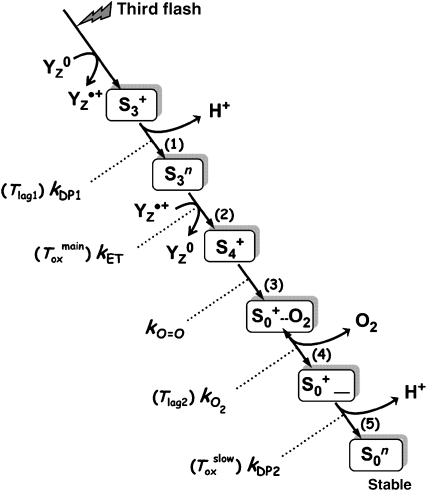Figure 8.
Proposed sequence of events induced by the third flash of saturating light applied to dark-adapted PSII. The initial oxidation of YZ, a specific redox-active tyrosine residue, is followed by the removal of a proton from the Mn complex (step 1) and only subsequently by electron transfer from the Mn complex to YZ•+ (step 2). The latter ET step is kinetically indistinguishable from O2 formation and the associated reduction of the Mn complex (step 3). The subsequent dioxygen release (step 4) is assumed to be reversible. Finally, a second proton is removed from the Mn complex (step 5), a process that may involve a significant rearrangement of the Mn ligand environment. Steps (1) and (5) are assumed to be accelerated by the Cah3/HCO3− system. The given time constants refer to possible contributions to the O2-release signal, which accordingly may reflect not only Toxmain but also Tlag1 and Tlag2 as well as Toxslow (the latter only in PSII(Cah3−) in the absence of HCO3− or Cah3). In the nomenclature used here, the S-states refer to states of the Mn complex. The states S3, S4 and S4′ of Haumann et al (2005) correspond to states S3+, S3n and S4+, respectively. The subscripts indicate the number of oxidizing equivalents accumulated by the Mn complex, and the superscripts refer to the relative charge of Mn complex, which is assumed to be either neutral (n) or single positive charge (+).

